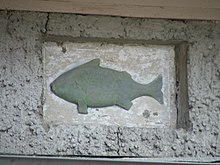City corner
Stadtwinkel ( Lower Sorbian : Rukow ) was a suburb and independent municipality, which was incorporated into Liebenwerda in 1874 .
history
First mention
Stadtwinkel was first mentioned in a document in 1531: the fishermen in Wingkel zu Liebenwerd in front of the town uffn Rugkocz . According to oral tradition, the place should have been a Slavic fishing village, which should have existed even before the first mention of Liebenwerda in 1231. However, this has not yet been confirmed archaeologically . Presumably to demarcate Winkel near Wahrenbrück and the Freiwinkel district, the prefix Stadt- .
Local history
The inhabitants lived mainly from growing herbs, vegetables and culinary herbs, from fishing, line weaving and daily wages. It is documented that the place had its own court with local judges and lay judges . The residents were obliged to do compulsory services in Liebenwerda Castle . The Stadtwinklers tilled the vineyards, harvested the hay in the large meadows and the “Elzbusch”, grew vegetables in the (official) garden and harvested hemp. In winter they had to do duty in the castle and at the request of the rulers make the beds in the castle. For this they were paid 1 shock 59 groschen in money in 1589. Furthermore, the Stadtwinkler had to do construction services in the castle and cook for the gentlemen in the castle. Even tidying up and scrubbing floors and waxing were part of the duties. But they were allowed to fetch dry wood from the electoral woods . In 1589 there were 34 possessed men . In 1799, 35 families with 111 people and 45 cows lived in Stadtwinkel.
Again and again there were conflicts between the Stadtwinklers and the Liebenwerdaern. As citizens with civil rights, the Liebenwerdaers had certain privileges, which the villagers of Stadtwinkel also wanted to make use of. The real problem was that the Stadtwinkler farmers did not have sufficient pasture land, whereas the arable citizens of Liebenwerda were adequately equipped with it. The townspeople often claimed that a third of the Frauenwiesen belonged by God and by law to them, but this could be refuted by a document from 1424. So it came to a scandal on June 28, 1670 . The Stadtwinkler had once again let their cattle graze on the women's meadows, which belonged to the citizenry. The council of Liebenwerda decided without further ado that the cattle should be confiscated in order to permanently prevent the use of the meadow by the Stadtwinkler. In a wild hunt, 16 citizens, among them councilors such as the treasurer Johann Thär, the city judge Christoph Eschenbach and the city clerk Johann Andreas Dreßler, tried to catch the cows. However, the cows fled and a chase began in which some animals escaped. The problem now was how to return to the city without getting too close to the city corners. It was decided to lead the animals through a ford in the Black Elster ( through the ford near Martin Grünenwalds Wießgen. ). The campaign succeeded, and the owners of the animals each had to pay a deposit of four groschen and demurrage to the council of the city of Liebenwerda. In fact, there was no more illegal use of pastureland. However, a hundred years later, during the chaos of the Seven Years' War, the Stadtwinklers managed to take possession of a third of the Frauenwiesen .
Until the regulation of the Black Elster from 1852 there was a great abundance of fish in the region. Between Elsterwerda and Liebenwerda alone there were over 27 Elster arms. In addition to crabs, fish such as the magpie eel, salmon and catfish were caught. Over time, a lively fish trade developed especially to Dresden .
Until the founding of the Liebenwerda district , Stadtwinkel was an official village of the Liebenwerda office . It then continued to exist as an independent municipality until 1874.
Individual evidence
- ↑ Emilia Chrome: The place names of the Bad Liebenwerda district. Akademie-Verlag, Berlin 1968.
- ^ Fitzkow: Heimatkalender Kreis Bad Liebenwerda 1955. P. 101.
- ^ Carl von Lichtenberg: The Chronicle of the City of Liebenwerda. 1837, p. 54.
- ↑ Stadtwinkel parish register from 1646.
- ↑ Friedrich Gottlob Leonhardi: Earth description of the electoral and ducal Saxon lands. 1802, pp. 510, 513.
- ↑ Matthäus Karl Fitzkow : The capture of the Stadtwinklerkühe. In: Local calendar of the Bad Liebenwerda district 1955. P. 101 ff.
- ^ Felix Hoffmann: The Stadtwinkler fishing company in Liebenwerda. In: Märkische Heimat. Issue 4, 1957.
Coordinates: 51 ° 31 ' N , 13 ° 23' E



